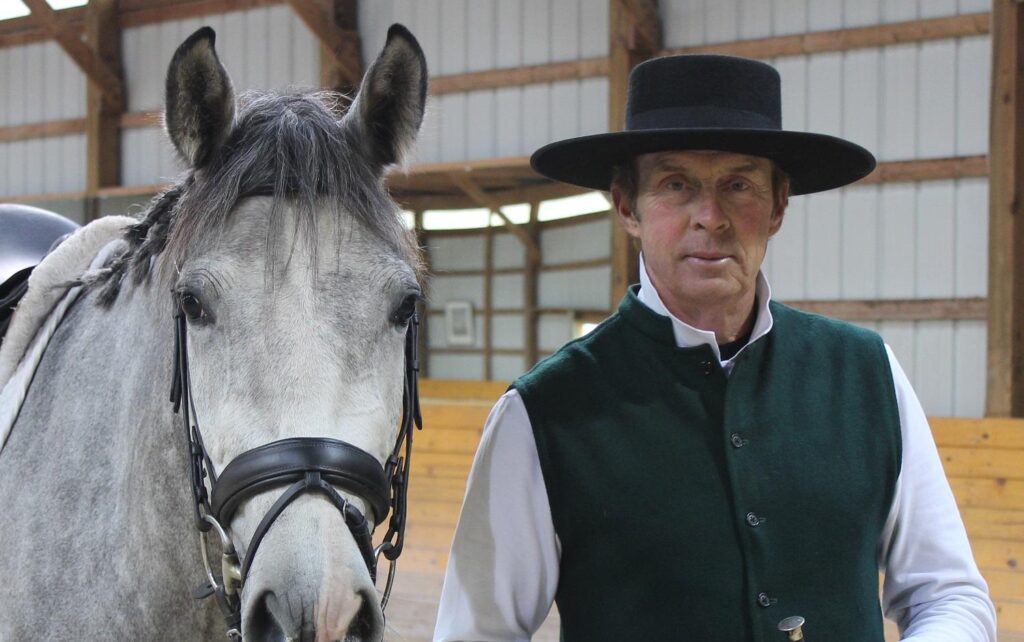
By Paul Belasik
As he promised in his last article, Paul has returned ready to ‘face a beast that has challenged some of the greatest equestrian minds and bodies throughout history. A Beast That Can Block All Your Knowledge of Collection’. Crookedness:
One of the greatest French equestrian minds, Alexis-Francois L’Hotte said, “Calm, forward, straight!” One of the greatest German equestrian minds, Gustav Steinbrecht said, “Ride your horse forward and set it straight.” When two great riders give almost identical advice, it seems to me that we should pay attention.
In my last article, I talked about how in particular, faulty neck position can interfere with the process of balancing the horse longitudinally and the building the strength necessary for correct collection, how the neck can be a ‘spoiler’ to this difficult process. I alluded to another looming beast of a challenge in training the dressage horse: this challenge is crookedness.
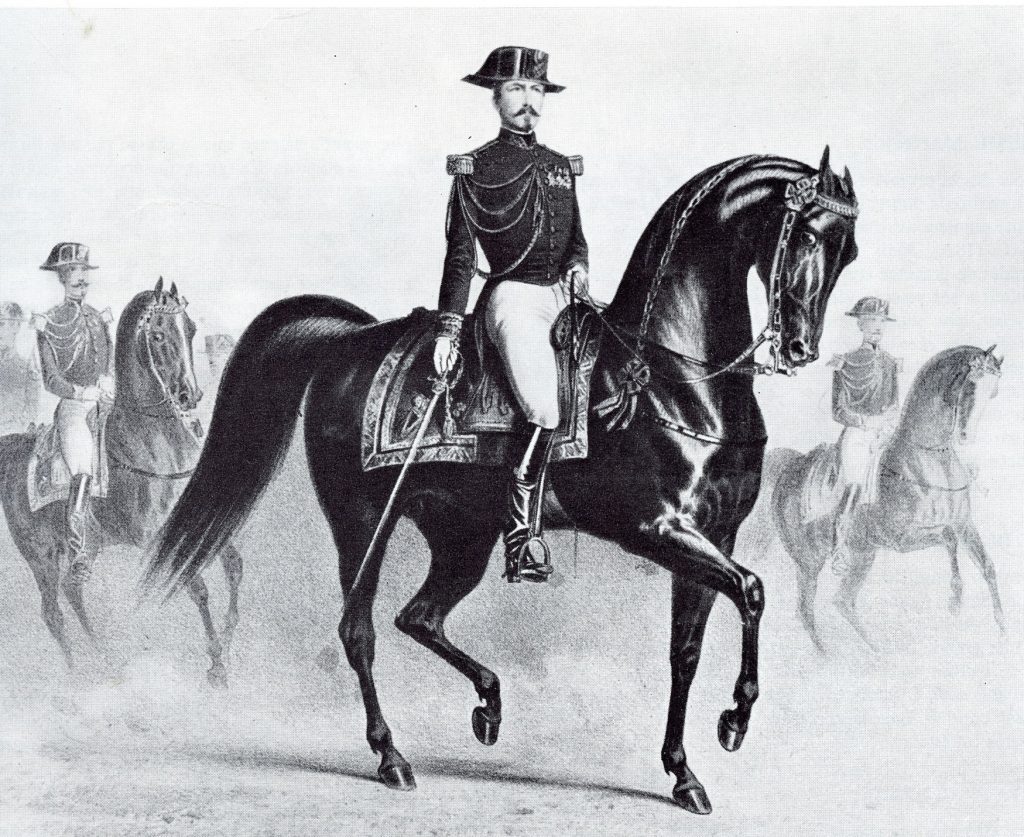
Calm, forward and straight…
Of all the profound things Steinbrecht and L’Hotte said, the above quotes have stood out over time because they refer to the universal problem of crookedness, the opposite shadow side of the straightness they are promoting. Crookedness can be very complicated. Unlike the balance of collection, which we address gradually with balancing tests and exercises becoming more difficult as we progress, crookedness was there before we started training. Unless one is blessed with a very, very rare animal that is truly ambidextrous, it comes at us full force from the first days of training. In fact, it is probably at its worst in the very beginning, and yet the trainer has not imported any skills yet to address it. It will have to be monitored throughout training and it can be come back to if the horse gets overtrained or fatigued or sore.
At the heart of the idea of straightness is that it is a correction for crookedness. The heart of crookedness is embedded deep in the evolution of many species. In mammals, it seems to be connected to the split-brain anatomy, where there are two hemispheres doing different things, but coordinated by sharing information across this divide. A result of this anatomy is a preference to use one side of the body over the other, or right or left handedness.
Why is the addressing of crookedness important in dressage? If you plant a tree in a space where it has ample light from all sides it will grow up to have a well-balanced crown supported by a well-balanced root structure. If you plant a tree next to a building, it will grow crookedly, with the branches on one side reaching for the light, the branches on the side of the wall withering and stunted. In due time, this imbalance can cause it to tip over. I cannot tell you how many fences I have had to fix over the years from trees growing toward the open space of the pastures, completely out of balance until they eventually fall over in the slightest storm. The desire for symmetry, “straightness,” in training the dressage horse is an homage to the idea that symmetry is healthy. Dressage movements to the left and right celebrate or expose a trainer’s attention to this fundamental requirement.
Later, dressage movements can be artistic expressions demonstrating expertise and balance. As in dance, this balance and symmetry becomes a strong component in judging the quality of a performance, but it is always rooted in this idea that it is a healthy pursuit for the horse and rider.
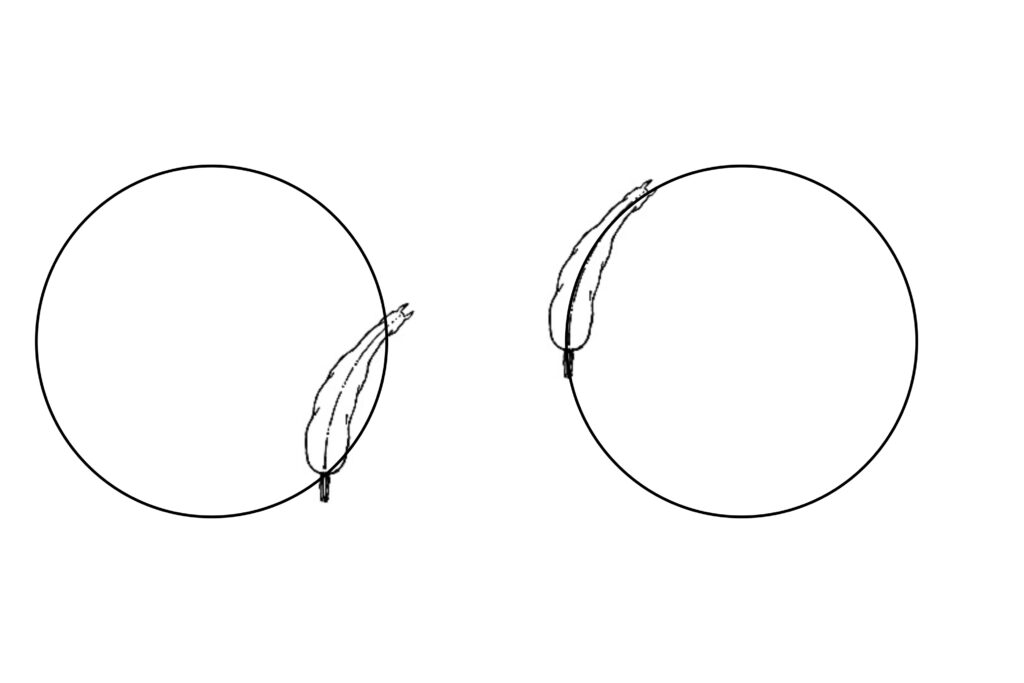
When this horse is circling right, it has a nice easy bend. On the circle to the left, is the horse resistant to the left leg and rein or are the muscles of the right side staying contracted, not allowing the horse to bend left, even going in the other direction? Riders have to become comfortable with these dualities, when two things can be true at the same time.
Crookedness can be very complicated. Let’s look at a very simple example. My horse seems to bend easily to the right on a circle, it is relatively light in the reins, seems to bend its rib cage around the rider’s “inside” right leg and goes forward without too much resistance. However, when I try to circle to the left, the horse gets heavy in my left rein, leans into my “inside” left leg and slows down with obvious resistance to a left bend.
Your first impression as the rider might be that the right side is the problem. You start all kinds of scenarios to address this resistant side of the horse. What if the reason the horse would not bend to the right is because the muscles on the left side are staying contracted, so going to the left feels fine, but when you switch to the right, they won’t let go? This is a simple example of the Zen riddles we face in training all the time. One has to become comfortable with these dualities. The answers are usually that it can be both things at once. (Often resistances can be muscular on one level and neurologic on a deeper level.)
Data and Decisions
In the course of training, you will not be able to call a veterinarian every time you encounter puzzling resistances or uneven steps, as in a rein lame horse. Even if you could, examination and expensive tools might reveal nothing definitive. There can come a point where more data will not make for better decisions. In these cases, the trainer proceeds like a good physical therapist. The beauty of the classical exercises is that they can have a diagnostic quality to find stiffnesses, weaknesses, crookedness. The same exercises, when repeated carefully and increasingly, can have a restorative, correcting, and strengthening effect.
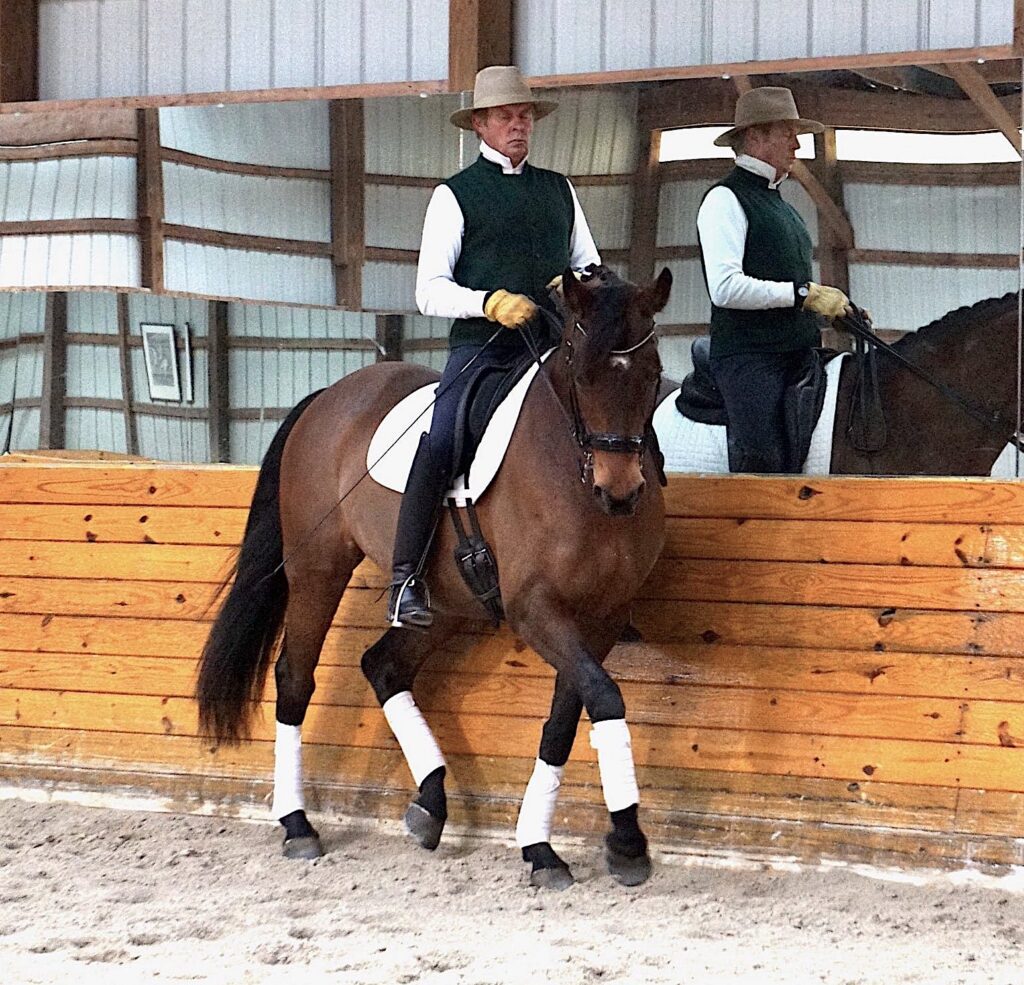
You can’t make a horse straight by riding it straight. You have to unequally address the lack of dexterity, the weaknesses, the stiffness on one side.
The interesting thing about straightness is you cannot make a horse truly straight (re. symmetrical) by riding it straight. You have to unequally address the lack of dexterity, the weaknesses, the stiffness on one side. The pursuit of symmetry will not be without discomfort and frustration. In terms of neural science, you have to interrupt the brain’s habituated responses and teach another, etching new motor and neural pathways. Anyone who has practiced any form of meditation knows how difficult it is to stop the mind from its habits. At the same time, you will have to change the skeletal-muscular physiology. It takes time to break down bad habits or unbalanced habits and build new ones.
The horse can’t tell you when it might be enough for the day or they can tell you it’s too much before you even start. You have to become a very good observer to try to find the truth. You will need patience, to let these things reveal themselves.
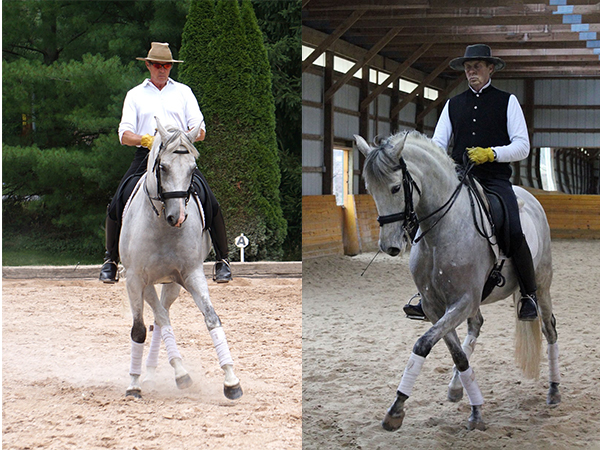
Symmetry can be learned, overcoming the brain’s preference for a dominant side. The classic exercises serve as both a diagnostic tool and have a corrective effect.
Symmetry can be learned. In many cases, it will be overcoming the brain’s preference for a dominant side through patient repetition of exercises to change the physique. The trainer has to keep in mind the complexity involved. Think of opening a jar with a tight lid. You may use your dominant or strong hand to twist the lid, but your other hand must hold the jar. Without its support it will be impossible to open the jar. Concepts like an inside and outside rein are like this, pairings made even more difficult by requiring the person to switch hands and legs. Riding has to address these unbalances from the beginning to end. They are a constant practice.
In these most recent two articles I have barely scratched the surface in exploring the longitudinal field of balance and the lateral field of balance in training for dressage. If you take up the practice of dressage and get caught in the minutia of this muscle or that vertebrae, or how these things can help you win prizes, you don’t understand that dressage can be a metaphor which can teach you some of the finer points of balance you can apply to your whole life. I’m afraid you may have missed the whole point of dressage.
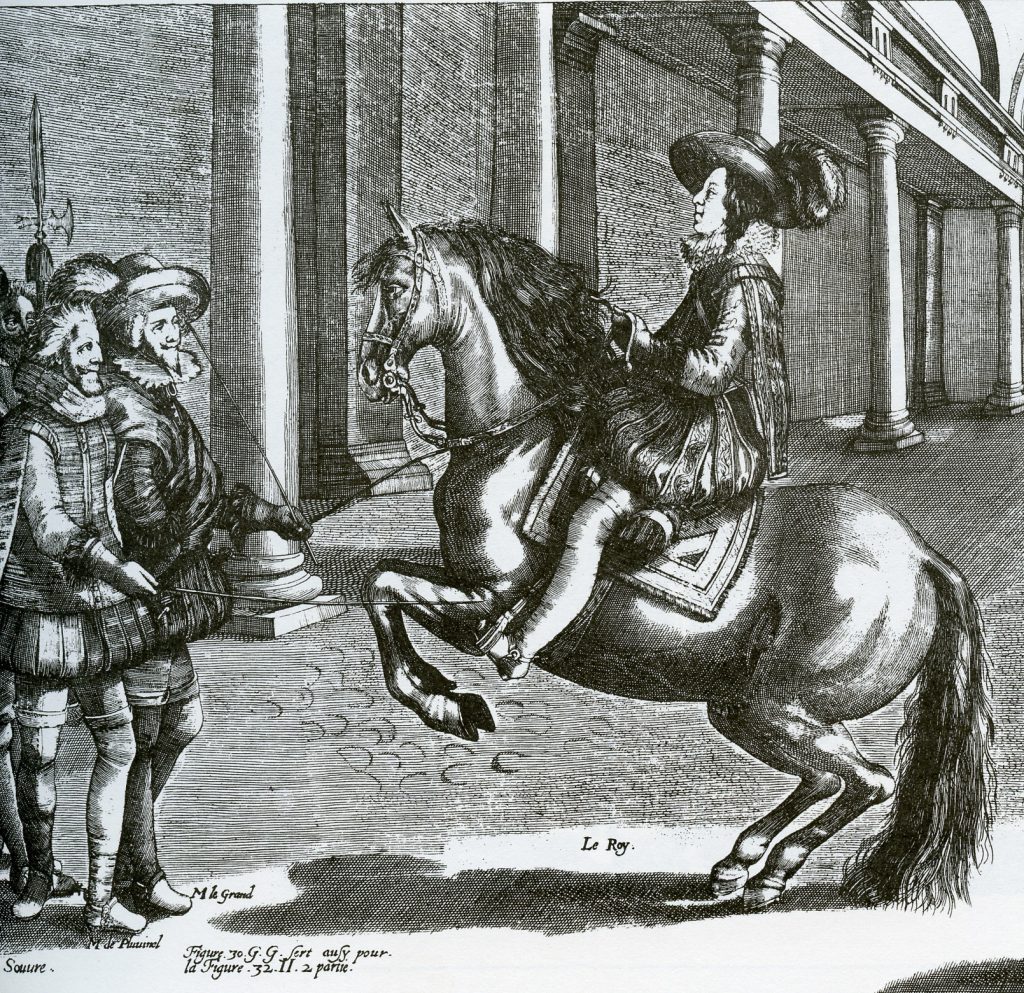
As the great Pluvinel told the King of France, “Thus your majesty can see quite clearly how useful this beautiful exercise is to the mind since it instructs and accustoms it to perform with clarity and order all these functions amid noise, worry, agitation and the fear of constant danger.”*
*(Pluvinel, The Maniege Royal. Müller: 1626, Braunschweig. Trans. Hilda Nelson. JA Allen: 1969, London.)



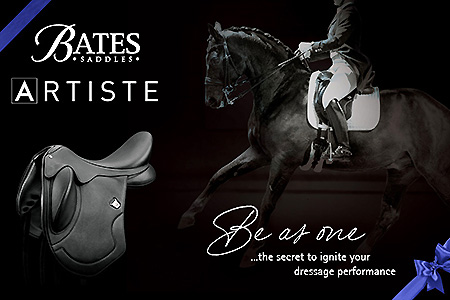
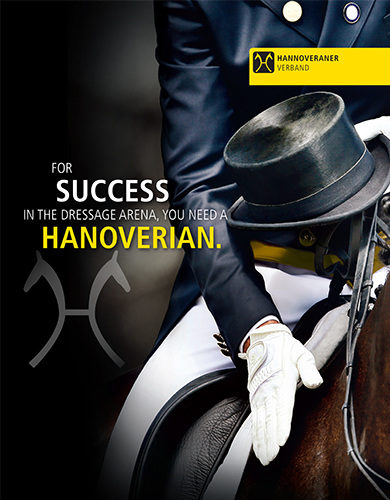
Wonderful article . Having a horse that is quiet, obedient, and supple, will contribute immensely to this exercise. If you are missing one of these ingredients it can make it very hard, very difficult, to achieve the desired results.
At last hearing about the importance of lateral bend.
I was always taught lateral bend came before longitudinal bend; the reasons for movements such as shoulder in as an elementary beginning to have your mount supple pre more collected gaits.
I am so pleased to hear the comments regarding the “missing the plot” in modern dressage as I think this happens a great deal.
Thankyou for your article.
Absolutely perfectly true . Understanding this is so often missed at the disadvantage to the horse . The actual message to the horse has to be clear & simple Love the old Masters books .
“ the horse doesn’t read the darn book !! “ … once said to me by a respected trainer